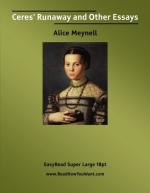Now the plaid is not only “cut off” from natural sources, as Ruskin says of Oriental design—the plaid is not only cut off from nature, and cut off from nature by the yard, for it is to be measured off in inorganic quantity; but it is even a kind of intentional contradiction of all natural or vital forms. And it is equally defiant of vital tone and of vital colour. Everywhere in nature tone is gradual, and between the fainting of a tone and the failing of a curve there is a charming analogy. But the tartan insists that its tone shall be invariable, and sharply defined by contrasts of dark and light. As to colour, it has colours, not colour.
But that plaid should now go so far afield as to decorate the noble garment of the Indies is ill news. True, Ruskin saw nothing but cruelty and corruption in Indian life or art; but let us hear an Indian maxim in regard to those who, in cruel places, are ready sufferers: “There,” says the Mahabharata, “where women are treated with respect, the very gods are said to be filled with joy. Women deserve to be honoured. Serve ye them. Bend your will before them. By honouring women ye are sure to attain to the fruition of all things.” And the rash teachers of our youth would have persuaded us that this generous lesson was first learnt in Teutonic forests!
Nothing but extreme lowliness can well reply, or would probably be suffered to reply, to this Hindu profession of reverence. Accordingly the woman so honoured makes an offering of cakes and oil to the souls of her mother-in-law, grandmother-in-law, and great-grandmother-in-law, in gratitude for their giving her a good husband. And to go back for a moment to Ruskin’s contrast of the two races, it was assuredly under the stress of some too rash reasoning that he judged the lovely art of the East as a ministrant to superstition, cruelty, and pleasure, whether wrought upon the temple, the sword, or the girdle. The innocent art of innocent Hindu women for centuries decked their most modest heads, their dedicated and sequestered beauty, their child-loving breasts, and consecrated chambers.
TWO BURDENS
One is on the breast and clings there with arms, and one on the back and clings with thongs. The burden of the back bows the body, turns the face from the sky, narrows the lungs and flattens the foot; takes away the flight and the dance from the gait of man, and ties him towards the earth—not only in the way of nature, by means of his arched feet, but by a heavy lien upon his shoulders and his brows. It is the fardel that makes this vital figure to be subject visibly, and at several points, to that law of gravitation which, in a state of liberty, it uses to withstand, to countervail, to leap from, to walk with, making the universal tether elastic. Bend in two this supple spine that can lift itself, like a snake erect, with something better than mere balance—with life and the active will; bend the back, and at once gravitation takes hold of the loins and grasps the knees, and pulls upon the shoulders, and the neck feels the weight of an abject head.




